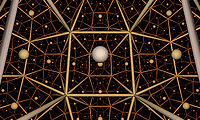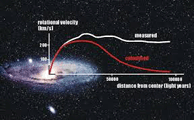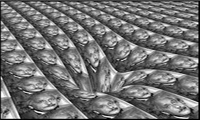| |
Oradores Convidados.
2º Dia (dia 20 de Novembro 9h30-12h30 e 14h30-18h30)
TEMA 2 "Relatividade Geral no século XXI"
Dedicado a investigadores e outro
público interessado.
LOCAL: Anfiteatro 0.07
(Departamento de Matemática, Faculdade de Ciências
da Universidade do Porto, Rua do Campo Alegre s/n,
4169-0097 Porto)
- José Velhinho (Universidade da Beira
Interior. Departamento de Física) homepage
Título:
|
Loop
Quantum Cosmology and Singularity Resolution
|
| Resumo: |
The application of Loop Quantum
Gravity methods to standard models in cosmology
opened the way to new insights on the
gravitational physics of spacetime regions where
General Relativity predicts the existence of
singularities, namely in the very early
universe. In the present talk, a summary
of this so-called Loop Quantum Cosmology
approach is presented, focused on the issue of
singularity resolution in homogeneous and
isotropic models. |
- Pedro Gil Vieira (Centro de Física do
Porto)
homepage
| Título |
Holography
and Integrability. Solving String Theory |
| Resumo: |
Currently,
our best description quantum gravity comes about
through a remarkable correspondence which states
that fully quantum theories of gravity admits an
alternative description in terms of simpler
theories (quantum mechanical but without
gravity) in the boundary of space-time. Simply
put, because the boundary has one less
dimension, this is equivalent to saying that we
might be described by an hologram. Describing
these boundary theories in full detail would be
tantamount to obtaining the first sound
description of quantum gravity, a much sought
after holy grail of theoretical physics. I will
explain how a new player by the name of
integrability recently came into the game and is
bringing us closer and closer to this
goal. |
- Nelson Nunes (Departamento de Física da
Faculdade de Ciências da Universidade de Lisboa) homepage
| Título |
Cosmology
of the de Sitter Horndeski models |
| Resumo: |
The
discovery, in 1998, that the Universe is
currently undergoing an accelerated expansion is
one of the greatest milestones in all physics.
Naturally, over the last 15 years, many
proposals to explain this evolution have been
brought forward. Most ideas involve scalar field
dark energy or extensions of Einstein's gravity.
These proposals are essentially phenomenological
without any relation to each other. One major
step forward was the realization in 2011 that
all this models are subclasses of the most
general scalar-tensor theory that leads to
second order equations of motion, the Horndeski
Lagrangian.
I will describe how one can construct a subclass
of the Horndeski Lagrangian with a de Sitter
critical point for any kind of material content.
These models might alleviate the cosmological
constant problem. I will present the
cosmological evolution of two classes of
families - the linear models and the non-linear
models with shift symmetry. We conclude that the
latter models can deliver a background dynamics
compatible with the latest observational data.
|
- Robertus Potting (Departamento de Física da
Faculdade de Ciências e Tecnologia da Universidade do
Algarve) homepage
| Título |
Massive gravity and
spontaneous symmetry breaking |
| Resumo: |
General
relativity predicts that gravitational waves
propagate with the speed of light. In particle
physics language, this means that gravitons are
massless, just like photons. In the late
thirties of the last century, Fierz and Pauli
showed that one can construct a theory of a
massive spin-2 field by adding a specific mass
term to the linearized Einstein-Hilbert action.
However, later efforts to promote the model to a
fully interacting one ran into serious
theoretical difficulties, including
instabilities due to the appearance of a ghost
mode. In 2010 de Rham, Gabadadze, and Tolley
managed to construct a nonlinear theory of
massive gravity with a carefully tuned potential
that avoids the ghost mode at all orders. I
review this model and discuss global aspects of
the potential, in particular whether it might
allow spontaneous breaking of Lorentz symmetry.
|
- Francisco Lobo (Departamento de Física da
Faculdade de Ciências da Universidade de Lisboa)
homepage
| Título |
Beyond
Einstein's General Relativity: 100 years-on
|
| Resumo: |
Modern
astrophysical and cosmological models are
plagued with two severe theoretical
difficulties, namely, the dark energy and the
dark matter problems. Relative to the former,
high-precision observational data have confirmed
with startling evidence that the Universe is
undergoing a phase of accelerated expansion.
This phase, one of the most important and
challenging current problems in cosmology,
represents a new imbalance in the governing
gravitational equations. Several candidates,
responsible for this expansion, have been
proposed in the literature, in particular, dark
energy models and modified gravity, amongst
others. Outstanding questions are related to the
nature of this so-called "dark energy" that is
driving the acceleration of the universe, and
whether it is due to the vacuum energy or a
dynamical field. On the other hand, the
late-time cosmic acceleration may be due to
modifications of General Relativity, which
introduce new degrees of freedom to the
gravitational sector itself. We analyze some of
the modified theories of gravity that address
these intriguing and exciting problems facing
modern physics, and explore the foundations of
gravitation theory, essential for the
construction of modified theories of gravity.
|
- Maria Piedade Machado Ramos (Departamento de
Matemática e Aplicações. Universidade doMinho)
homepage
| Título |
Relativistic
Elasticity: recent developments |
| Resumo: |
The theory of
elasticity in the context of general relativity
was developed in the mid twentieth century. The
need for such a theory came in the late 1950s
with Weber´s bar antenna for gravitational waves
in order to explain how these waves interact
with elastic solids. In 1973, a fully developed
nonlinear theory of elasticity adapted to
general relativity was given in a paper by
Carter and Quintana, which, to a certain extent,
remains as the standard reference of this
theory. In this paper the concept of elasticity
is formulated within the framework of general
relativity. In this talk, the theory of elastic
matter within the context of general relativity
is presented, following the formulation of
Carter and Quintana. The latest developments
within this theory will be discussed; in
particular, recent work on conformally flat
spacetimes associated to an elastic stress
energy tensor will be analysed. |
- Jorge Páramos (Centro de Física do
Porto) homepage
| Título |
Cosmological
dynamics of a non-minimal coupling between
matter and curvature |
| Resumo: |
In this talk
I review the fundamentals of a model exhibiting
a non-minimal coupling between matter and
curvature and highlight its most interesting
features. I discuss the ensuing cosmology and
its formulation as a dynamical system, which
offers a powerful tool for probing interesting
candidates for dark energy models.
|
Horário dia 20
9h30-9h40
|
Homenagem a Pedro
Vieira (Early Research Award" (ERA) do Ministério
da Economia e Inovação do Ontario) +info
|
| 9h40-10h20 |
Pedro Gil
Vieira |
|
Coffee Break
|
| 10h50-11h30 |
Maria Piedade
Machado Ramos |
| 11h40-12h20 |
Jorge Páramos |
|
|
14h30-15h10
|
Nelson Nunes
|
| 15h20-16h00 |
Robertus
Potting |
| 16h00-16h30 |
Coffee Break
|
| 16h30-17h10 |
Francisco Lobo |
| 17h20-18h00 |
José Velhinho |
|




